You are here
Clay Hills Ashutas on Altai.


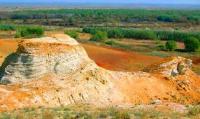
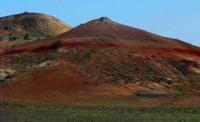
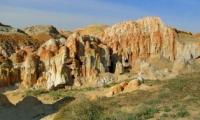
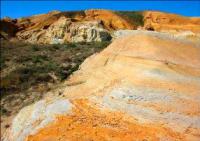
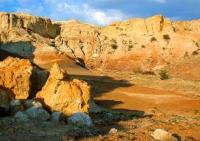
Journey through the Zaysan reservoir.
“Ashutas. Silence. Heat.
Sultry noon. Expire later.
A dinosaur should meet
Yes, he does not come across something"
Ust-Kamenogorsk professor-zoologist K.P. Prokopov.
A trip to the Ashutas valley.
Ashutas hill is located in the east of the Zaysan depression on the right bank of the Black Irtysh (48 ° 1 'N and 84 ° 4' E). The length of Ashutas from east to west is 7.5 km, the largest width in the middle part is 5 km. Black Irtysh approaches Ashutas at its southeastern outskirts, and then abruptly turns from steep slopes to the south and only at the southwestern outskirts approaches again, but not closer than 1 kilometer. (Ashutas in translation from the Kazakh language means sour, alum stone).
The relief is uniform, its surface is slightly dissected, almost flat. To the north, north-west and west from the hills run down shallow and shallow logs as a result of weathering and erosion. The predominant rocks of Ashutas are colored clays, fine-grained sands and sandstones, the underlying rocks are coarse-grained red sandstone and shale.
Toward the Black Irtysh valley, the Ashutas hill ends with terraces. The cliffs are cut by logs, which serve as a descent from a hill to the Black Irtysh valley. Loose clay from snow and rain water becomes soft, easily washed off. After rain it is impossible to walk on such clays - clay sticks to the shoes.
Streams of rainwater turn into streams of mud. At the bottom of Ashutas and even on adjacent floodplain meadows, these streams dry up. Deep ravines, crevices, holes, holes are all the result of the activity of water.
The fossil remains of plant and animal organisms on Ashutas were first discovered by V.V. Reznichenko in 1903. He assembled a small collection, which, together with materials collected in 1909 by engineer A.A. Kozyrev, was transferred to I.V. Palibin for study; he also has priority in the appearance of literary data on the tertiary flora of Ashutas.
N.N. Belyaev and A.N. Sedelnikov began research on the fossil flora and fauna of Ashutas almost simultaneously. N.N. Belyaev in 1909 - 1910 collected on Ashutas fossil remains of plants and animals. A.N. Sedelnikov, curator of the Museum of the West Siberian Branch of the Russian Geographical Society in Omsk, in 1910 made a detailed description of Ashutas and collected a large collection of prints of fossil plants.
Among them were willow, poplar, birch, oak, liquidambar, linden, palm, hazel, fern, conifers, beech, maple, plane tree, hornbeam, hazel. “... That which was met exceeded our expectations. Ashutas is, of course, of great scientific value. Here is the richest and well-preserved material on phytopaleontology, mainly tertiary flora.
Based on our preliminary studies, we can already say that Ashutas and neighboring hills far exceed everything that was known so far from the tertiary flora of Western Siberia in the quantity and quality of the stored materia...
Such a rich island of fossil tertiary flora is hardly ever found in Russia (now in Kazakhstan - KP) (Sedelnikov AN A trip to the Ashutas hill (on the Black Irtysh). Notes of the Seven-Palatine Division of the West Siberian Department of the Imperial Russian Geographical Society. - Val. VI. - Semipalatinsk, 1912. S. 16).
Ashutas was then an island among the shallow freshwater basin of Zaysan, which occupied most of the current Zaysan depression. The whole area was occupied by a huge fresh lake, among which several islands towered, including the Ashutas hill.
Collections of fossil flora and fauna collected on the hills Ashutas VV Reznichenko, N.N. Belyaev and A.N. Sedelnikovs, attracted attention to the Ashutas location of specialists. For a detailed study of the fossil fauna and flora of Ashutas, the Geological Museum of the USSR Academy of Sciences in 1927 organized a special expedition led by M.F. Neuburg.
She collected very rich and beautifully preserved paleobotanical and paleozoological material. It turned out that the Ashutas field is the richest in Kazakhstan by the number of fossil species represented in it. M.F. Neuburg found that the fossil remains of Ashutas plants are confined to a five-meter pack of dark and light chocolate clays and clay siltstone of tertiary deposits that are exposed on Ashutas and have a thickness of 45 meters with a total thickness of 121 meters.
In one of his articles, M.F. Neuburg writes: “Regarding the vertical distribution, although there is some difference in the composition of the plants of the upper and lower horizons of the aforementioned five-meter bundle, it’s not so significant, so that it would be possible to make any age differences; with the indicated features of precipitation, it is, rather, if I may say so, a facies character. ” According to his materials, M.F. Neuburg established 70 forms belonging to 32 families.
In 1932, the botanist L.N. Rusanov collected samples of rocks with plant prints on Ashutas. A.A. Chiguryaeva studied spores and pollen from Ashutas samples. The number of fossil species of Ashutas significantly exceeds the number of species from other points of Kazakhstan, which indicates a richer composition of the flora of Ashutas.
The age of Ashutas flora is Oligocene. All Ashutas researchers paid attention to the variety of sediment colors: here are represented white, light yellow, light green, violet shades to velvety red and almost black. Such multi-colored deposits are often observed in the form of cliffs with blocks of dumps and talus.
The tertiary stratum of Ashutas is covered with grayish-yellow or light-brown loams, beneath them lies a thick stratum of dense white, yellowish and ocherous clay sands, which in some places pass into ferruginous sandstones and conglomerates with glandular crusts and nodules.
Still further below is the thickness of dense light-violet clays, in which leaf prints are already found; a layer of 2–5 m thick, composed of chocolate or brownish clays, is especially rich in them. In these clays there are continuous layers of roots, trunks, leaf prints and a layer of lignite or brown coal.
These clays are saturated with gypsum. Under chocolate clays with plants, in places lie dark gray, with a purple tint, loose gypsum-bearing clays with crystals and drusen of gypsum on the day surface. M.F. Neuburg described Ashutas section at 131 meters.
It is divided into three parts (from top to bottom): the upper part of the deposits consists of grayish-blue sandy clays and sandstones with interlayers of white limestone. It is separated from the middle part by coarse calcareous sandstone, under which are chalk marls with a thick interlayer of yellow loesslike loams, “white clays” with interlayers and lenses of coal, dark and light-clad clays with plant remains, light quartz sands and sandstones.
The base of this middle part of the section is underlain by a bed of ferruginous sandstone, under which lie greenish, red and yellow marls with ferruginous nodules and gypsum. The deposits of the entire section lie almost horizontally. In addition to plant imprints, brown clays contain the remains of insects, fish, and shells of mollusks.
The tertiary sediments that make up Ashutas lie on Paleozoic (more ancient) sediments. Ashutas plant fossils are found almost exclusively in the form of clean prints that differ little in color from the surrounding breed. All imprints are located on fragments of grayish-brownish rock - sandy schists, silts with abundant gypsum content.
Precipitation in the Ashutas region probably fell out of turbid water in a weak current, laid on the bottom and quickly covered with new sediment layers. The remains of aquatic and coastal plants are sometimes found in masses, overlap each other.
Apparently, they accumulated at the bottom of quiet plants, where the leaves of aquatic plants dropped in the fall. Almost all fossil prints represent whole, undestructed leaves. Among the residues, leaves of deciduous trees and shrubs predominate.
The remains of ferns, as well as grass in wet areas, are very rare and bear traces of a more distant transfer.The fossil flora of Ashutas has 79 species: 7 species are fern-shaped, 7 species are coniferous, 6 species are monocotyledonous, and 59 species are dicotyledonous. All of them belong to 58 genera.
Of 79 species of plants, 13, including ferns, herbaceous forms, and the remaining 66 species are woody and shrubby. These were aquatic, floating, near-water plants and lowlands inhabited on moist soil. Woody and some shrubbery plants grew in the monsoon type forest. As a part of the Ashutas forest, there were no thermophilic evergreens at all.
Ashutas' fossil forest was typically deciduous. The moist conditions of forest growth in the Ashutas region are evidenced by the large size of the leaves, the absence of hard-leaved forms, and the abundance of climbing plants.
Authority:
Prokopov K.P. Ashutas. Ust-Kamenogorsk: Media Alliance, 2006 .-- 216 s, 18VI 9965-704-08-2







